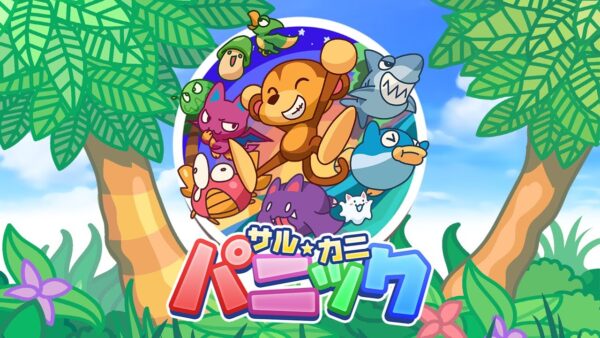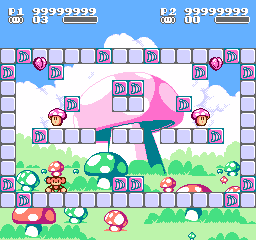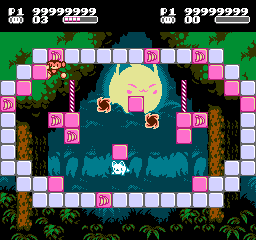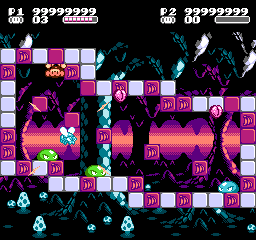
I recently had the chance to talk with Jesse and Brian from Work3, about their upcoming NES homebrew game Saru Kani Panic. Have a look below and enjoy
JB: Saru Kani Panic is a brilliant looking game for the NES/Famicom. What made you decide to design a game for the system at this time?
Jesse:
The NES homebrew scene has been pretty lively with more than a few standout titles released every year. Seeing these inspired me, and challenged me to see if we could try to top some of the games made by others. With the NES being extremely influential to my love of video games, it was fun to finally dive in and make a game for the system I grew up on. Combine that with getting to work with Brian, who is capable of producing top notch art and music, it seemed like an opportunity I couldn’t pass up.
Brian:
Thanks for the kind words! The conception of the game was simply from seeing other people producing NES software, seeing there was a viable market and finding out that coordinating the physical materials, such as cartridges and packaging wasn’t too difficult.
JB: How influential has the 8-bit homebrew scene been on you? Are there any games that have had an influence in how you have worked on Saru Kani Panic?
Jesse:
Micro Mages was a big inspiration for me. Seeing their work and dedication to building a fun and stylish game for the NES really made me wonder what we could pull off. Our game is not bound by the size limitations they set up for themselves- so we can put in even more art and content. Along with that I’ve been using the Nesdev wiki and the tutorials by Nesdoug to learn the ropes along the way. They’ve been invaluable resources for me and have certainly made me aim higher with some of the features we’ve been building into the game.
Brian:
Actually, the scene showed me that it was possible in terms of potential, but I have been involved in game development since the original 8 bit days, so really I take influence from my own game industry experiences. The huge success of
Micro Mages was a motivator as it showed there was an audience for NES games.
JB: What was your inspiration for the gameplay ideas in Saru Kani Panic? They seem like neat twists on some modern gameplay ideas
Brian:
I saw a very simple sliding puzzle game that was similar to the Pokemon ice puzzle stages a long time ago, and influences from classic games like Liquid Kids, Pang, Super Mario 3, Mr. Do, and even Pacman gradually all merged together in my head.
The overhead viewpoint of pokemon was changed to side on, which then creates an opportunity for gravity and to show a landscape type background.

JB: What are some of the challenges you have had with developing for a retro system, i.e. limitations hardware design issues and so on?
Jesse:
Oh man, there are plenty of challenges. The NES is a very capable system, however there is a steep learning curve if you want to get the most out of it. That said, learning to manage RAM and ROM has been tricky. Especially given that we have to swap out our code using bank switching- it took a few tries to get it working in a sane way. Good performance can also be hard to achieve. Our game is mainly written in C, however a lot of work has gone into tools and coding techniques to work around the performance impacts of this choice. Recently I’ve been going through the code and writing in assembly to handle more and more features.
Brian:
For me, it’s just about keeping my graphics optimized so they fit in memory. none of the stuff I do is as tricky as the code side.
JB: Saru Kani Panic looks far better than any NES/Famicom game that released during the system’s official lifespan did. What modern techniques have you applied to the game and what have you applied based on new insight into the system from the last couple of decades?
Jesse:
So much of that is thanks to Brian’s meticulous palette work. On the code side it’s mostly optimized systems like particle and animation systems to handle all the great sprites Brian has animated. With our super optimized sprite work, we’ve been able to structure the art in a way that we can easily load characters in and out cleanly in code, even mid-gameplay.
Brian:
The graphics praise always surprises me, I don’t think its far removed from games with great graphics such as Kirby, GUN-DEC, Street Fighter 2010 etc.
There have been speculations of clever “tricks” to make it look like it has more colours, special graphics chips, even that its not a NES game at all.. It’s just a standard NROM cart.
The graphics are drawn the old school way in a 2d pixel graphics tool, all the tools used to make sprite animations and background nametables are really no different than the tools I would use back in the 80s. The technique is draw the art, convert to tiles, then optimize, optimize, optimize until it all fits. The only modern tools I use is making prototypes using construct 2 to show examples of sprite movement for Jesse, and famitracker for the music.

JB:. Do you feel the NES/Famicom homebrew scene still has a lot left to offer? What would you like to see done by homebrew devs?
Jesse:
Definitely, the NES is still a powerful enough system to explore so many ideas and gameplay mechanics. I think it’d be great to see more contemporary side scrollers built for the NES. The biggest limitation of the NES is on the graphics side- but that doesn’t mean you can’t incorporate modern gameplay mechanics into it. I’d personally love to see some modern rouge-likes for the NES.
Brian:
Theres so much crazy stuff being done with hardware.. Wifi, on board Mp3 playback etc. I would love to see more innovation on the cartridge side.
Especially with sound chips..MP3 is cool, but extra sound options would be amazing.
The NES has been around so long and its limitations are very apparent so, really is up to designers to come up with great ideas and programmers being tenacious and smart enough to execute the ideas properly.
JB: Do you have any plans to bring Saru Kani Panic to modern systems after its initial release?
Brian:
Not sure yet, I want to get this version done before I think about that!
JB: Building on that, what is your goal with developing Saru Kani Panic? Do you hope to expand the game with sequels in the future? Perhaps new games with similar ideas?
Jesse:
We’d be so thrilled if we could sell enough copies (or just have enough people play it) to justify making more NES games. Having learned so much making Saru Kani Panic, I think making another game would be smoother- and both Brian and I have plenty of ideas for new games.
Brian:
I think some of the characters, especially Devilcat, who comes to chase you if you spend too long on a stage has good potential for a character for a new game, but I would rather concentrate on getting the current game finished before thinking much further.

JB: Do you see yourselves developing games for more retro systems as well going forward?
Jesse:
I think that remains to be seen, but you never know. I think the NES hits the sweet spot for homebrew development. The scope for an NES game fits nicely into a small team like ours- if you expand out to 16 bit systems or beyond the expectations and work required get much higher.
Brian:
I would love to do more, I would like to do a an MMC3 game for the NES, and I would like to do something on the PC Engine, but right now the NES market seems most popular, plus I think the overall cost for a PC engine cart would be preventitive!
JB: What is it about developing games for retro systems that is so appealing? Many developers do it, but what is the lure for a dev?
Jesse:
My biggest lure is certainly nostalgia. When I was a kid, I dreamt of making Nintendo games. That alone spurred me on into a career in gaming. It’s also fun to learn all the quirks and secrets of the system along the way. And it’s great that there is still a healthy community of gamers who want to play retro games- it’s a great feeling to make a game and finally put it out into the world to see people playing and enjoying it.
Brian:
For me, it’s being able to do everything yourself and not have to rely on a huge team.. The timeframes are short and scope is already reigned in by the hardware limits.

JB: Do you have anything you would like to say to the readers of Real Otaku Gamer?
Jesse:
Brian and I have been putting a ton of love and attention into Saru Kani Panic. We’d like nothing more than to get it into your hands. We’re really proud of what we’ve built so far, and we believe the finished product will be tons of fun!
Brian:
Thanks for reading, support the NES homebrew scene, and please look forward to Saru Kani Panic, once its finally finished!!!
You can follow Work3 on Twitter here
Their YouTube channel can be found here
Images Courtesy of Indie Gamer Chick
You can see a trailer for the game below
In addition, for access to an extensive variety of active retro gaming groups on Facebook, visit Retro Gamers Hub.

